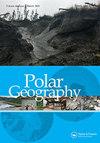阿拉斯加内陆高原的形态
IF 1.6
Q3 GEOGRAPHY, PHYSICAL
引用次数: 1
摘要
高原(冰冻)梯田是阿拉斯加内陆地区显著而广泛的高地景观元素。它们以阶梯状系列出现,主要沿山脊-峰顶位置的分界线出现,并作为峰顶平台出现。侧翼(边坡)由由粗碎屑碎屑和无定形溶蚀形式组成的陡峭上半部分组成,通过坡面断裂(“溶蚀”)分级到由明确的溶蚀裂片和低阶山坡水文网络主导的较平缓的下半部分(“溶蚀”)。一个独立的阶地单元由一个陡峭的陡坡(立管)和一个下缘的缓倾斜的踏面(平台)组成。一组连续的或一系列相邻的阶地单元,沿着山脊顶部从山顶平台下降,统称为高原。高原梯田是阿拉斯加内陆地区景观现象的一个显著特征,主要分布在915 - 1675 m.a.s.l之间的高原冰缘地带。它们位于当代雪线以下。三个研究领域给出了详细的口头、地图和摄影描述。这些地区(Mount Fairplay、High Valley/Denali山和goodpaste高地)可以作为高原地貌组合的典型地点。附录确定了阿拉斯加内陆许多其他地区包含发育良好的高原地貌的位置,并展示了这些地貌的广泛地理分布。本文章由计算机程序翻译,如有差异,请以英文原文为准。
The morphology of altiplanation in interior Alaska
ABSTRACT Altiplanation (cryoplanation) terraces are conspicuous and widespread elements of upland landscapes in Alaska’s interior. They occur in staircase-like series, primarily along divides in ridge-crest positions, and as summit platforms. Flanks (side slopes) consist of a steep upper section composed of coarse clastic debris and amorphous solifluction forms, grading through a break in slope (the ‘solischrund’) to a gentler lower section (cryopediment) dominated by well-defined solifluction lobes and low-order hillslope hydrological networks. An individual terrace unit consists of a steep scarp (riser) and a subjacent gently inclined tread (platform). A sequential group or series of adjacent terrace units, descending from a summit platform along ridge crests, are referred to collectively as an altiplanorium. Altiplanation terraces are a prominent feature of the altitudinal zonal arrangement of landscape phenomena in interior Alaska, and are confined to the upland periglacial zone between 915 and 1675 m.a.s.l. They are positioned below the contemporary snowline. Three study areas are given detailed verbal, cartographic, and photographic description. These areas (Mount Fairplay, High Valley/Denali Mountain, and Goodpaster Uplands) could serve as type localities for altiplanation landform assemblages. An appendix identifies the locations of many other areas in the Alaskan interior containing well-developed altiplanation landforms, and demonstrates the widespread geographic distribution of these landforms.
求助全文
通过发布文献求助,成功后即可免费获取论文全文。
去求助
来源期刊

Polar Geography
GEOGRAPHY, PHYSICAL-
CiteScore
5.30
自引率
0.00%
发文量
13
期刊介绍:
Polar Geographyis a quarterly publication that offers a venue for scholarly research on the physical and human aspects of the Polar Regions. The journal seeks to address the component interplay of the natural systems, the complex historical, political, economic, cultural, diplomatic, and security issues, and the interchange amongst them. As such, the journal welcomes comparative approaches, critical scholarship, and alternative and disparate perspectives from around the globe. The journal offers scientists a venue for publishing longer papers such as might result from distillation of a thesis, or review papers that place in global context results from coordinated national and international efforts currently underway in both Polar Regions.
 求助内容:
求助内容: 应助结果提醒方式:
应助结果提醒方式:


